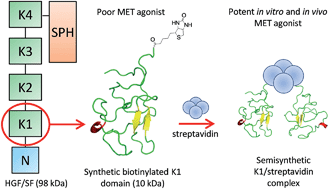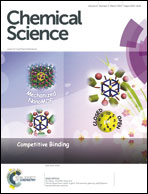Semi-synthesis of a HGF/SF kringle one (K1) domain scaffold generates a potent in vivo MET receptor agonist†
Abstract
The development of MET receptor agonists is an important goal in regenerative medicine, but is limited by the complexity and incomplete understanding of its interaction with HGF/SF (Hepatocyte Growth Factor/Scatter Factor). NK1 is a natural occurring agonist comprising the N-terminal (N) and the first kringle (K1) domains of HGF/SF. In the presence of heparin, NK1 can self-associate into a “head to tail” dimer which is considered as the minimal structural module able to trigger MET dimerization and activation whereas isolated K1 and N domains showed a weak or a complete lack of agonistic activity respectively. Starting from these structural and biological observations, we investigated whether it was possible to recapitulate the biological properties of NK1 using a new molecular architecture of isolated N or K1 domains. Therefore, we engineered multivalent N or K1 scaffolds by combining synthetic and homogeneous site-specifically biotinylated N and K1 domains (NB and K1B) and streptavidin (S). NB alone or in complex failed to activate MET signaling and to trigger cellular phenotypes. Importantly and to the contrary of K1B alone, the semi-synthetic K1B/S complex mimicked NK1 MET agonist activity in cell scattering, morphogenesis and survival phenotypic assays. Impressively, K1B/S complex stimulated in vivo angiogenesis and, when injected in mice, protected the liver against fulminant hepatitis in a MET dependent manner whereas NK1 and HGF were substantially less potent. These data reveal that without N domain, proper multimerization of K1 domain is a promising strategy for the rational design of powerful MET agonists.



 Please wait while we load your content...
Please wait while we load your content...